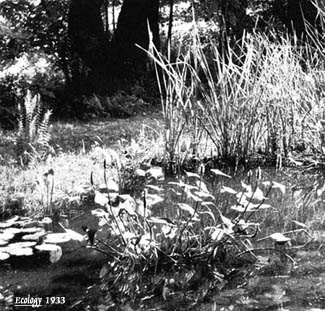 |
|
|
The idea of an outdoor ecological lab was conceived in 1920 by Edith A. Roberts, professor of Botany at Vassar College (PK New Yorker 1948). The laboratory was created for the public to gain greater understanding of the diverse plant species and communities native to Dutchess County. Edith Roberts and Mildred Southwick designed the laboratory to emphasize the aesthetic and economic use of native flora, as well as scientific value. The approximately 4 acre area on the Southwest edge of Vassar College Campus (map), was developed in 1922 for the outdoor laboratory by Miss Roberts and Miss Mildred D. Southwick, later a professor of Plant Ecology at Vassar, and George Gebhardt (PK New Yorker 1948). For several years beforehand, the designated area was a vast field of poison ivy with two oak trees (PK New Yorker 1948). In order to determine which plants should be grown in the laboratory, a two-year study of the flora of Dutchess County was conducted to determine which plants were native and in which natural associations (habitats) they occurred (Roberts 1938). The study was conducted by Vassar faculty and students and subsequent results were compiled into airplane maps and publications such as The Role of Plant Life in the History of Dutchess County (1938) and American Plants for American Gardens (1929). Outside lectures given by Edith Roberts funded the construction of the lab, including the limestone wall that surrounds the lab. Native plants were grown from seed or salvaged from development projects and transplanted into the outdoor laboratory or an adjacent greenhouse. Over 30 years of experimental and observational data collected on this land gave way to dissertations and student ecological and botanical studies, many of which were directed by Edith Roberts. The area encouraged the use of native plants for observational and experimental research, as a means of protecting the continual growth of native flora of the region.
The idea behind the Dutchess County Outdoor Ecological Laboratory, as explained by its founder Edith Roberts, Professor of Botany, Vassar College: "With the desire to make possible the fullest utilization of the plant life of the county, through a complete knowledge of the individual plants of each of these associations, President Henry Noble MacCracken and the Board of Trustees at Vassar College made it possible for the Department of Botany to develop the Dutchess County Outdoor Ecological Laboratory. It is planned to have established in this outdoor laboratory…all the plants native to the county and to have available the Department of Botany information as to the production, and aesthetic and economic use of all the plant members of the various associations." (Roberts 1938, 31)
As of April 1948, nearly all of the 2,000 identified plants native to Dutchess County, could be found growing in natural conditions in the plot (PK New Yorker 1948). Studies conducted on plants growing in the lab uncovered valuable information on the growth and reproductive patterns of various species. Within the plot, the native plants of Dutchess County grow in their natural associations, i.e. among the groups of plants a species commonly grows with. These associations, or habitats, include open fields, shrub groups, various woodland associations, and bog and aquatic groups. A study on the flowering dogwood, a threatened native, determined required periods of seed dormancy before growth and timing until blooming; these data enabled the re-establishment of the flowering dogwood and future commercial growth for gardens. The outdoor laboratory inspired graduated Vassar students to continue research in plant conservation in their respective states across the United States. Dutchess County Outdoor Ecological Laboratory was the first laboratory of its kind in the country and served as a model for future outdoor labs (PK New Yorker 1948). Edith Roberts retired from Vassar College in 1948. The Poughkeepsie New Yorker wrote an article in 1948, just before she retired, when the laboratory appeared to be at the height of its use and recognition. The article states that the laboratory hopes to promote the basic principles of conservation. Unfortunately, when she left, the ecological laboratory was neglected and the gardens soon were overgrown by noxious weeds and evasive plants.
Flooding. The ecological laboratory was once fairly dry land with a brook running through it. After 1964, the area was flooded with water from the Vassar Lake, lying across Raymond Avenue (Wright pers comm). The induction of water changed the dynamics of the ecosystem and has made the area the wetland we recognize today.
Construction of the Priscilla Bullitt Collins Trial: Priscilla Bullitt Collins, class of ’42, donated the funding for the construction of a boardwalk running lengthwise through the wetland along the Fonteyne Kill.
BIOGRAPHY Miss Roberts grew up as the daughter of a farmer in Rollinsford, NH. She was educated at Smith College and the University of Chicago. Before becoming a professor of botany at Vassar College, she taught at Mt. Holyoke and the University of Chicago. She became associated with Vassar in 1920, where she served as Professor of Botany (later changed to Plant Sciences) for almost 30 years. She was the founder and director of the Dutchess County Outdoor Ecological Laboratory at Vassar College. During her years at Vassar, she conducted many studies on the geology and fauna of Dutchess County. In connection with the work in the Ecological Laboratory, Roberts became a consultant for several national organizations interested in plant conservation (PK New Yorker 1948). PUBLICATIONS
"Outdoor Ecological Laboratory At Vassar, First of Kind in U.S., Bears Most of Area's Native Plants" PK New Yorker, April 5, 1948. Egan, Dave. Winter 1990. "Historic Initiatives in Ecological Restoration" . Restoration & Management 8:2. 83-90 Wright, Margaret. 2001. Personal Interview. |